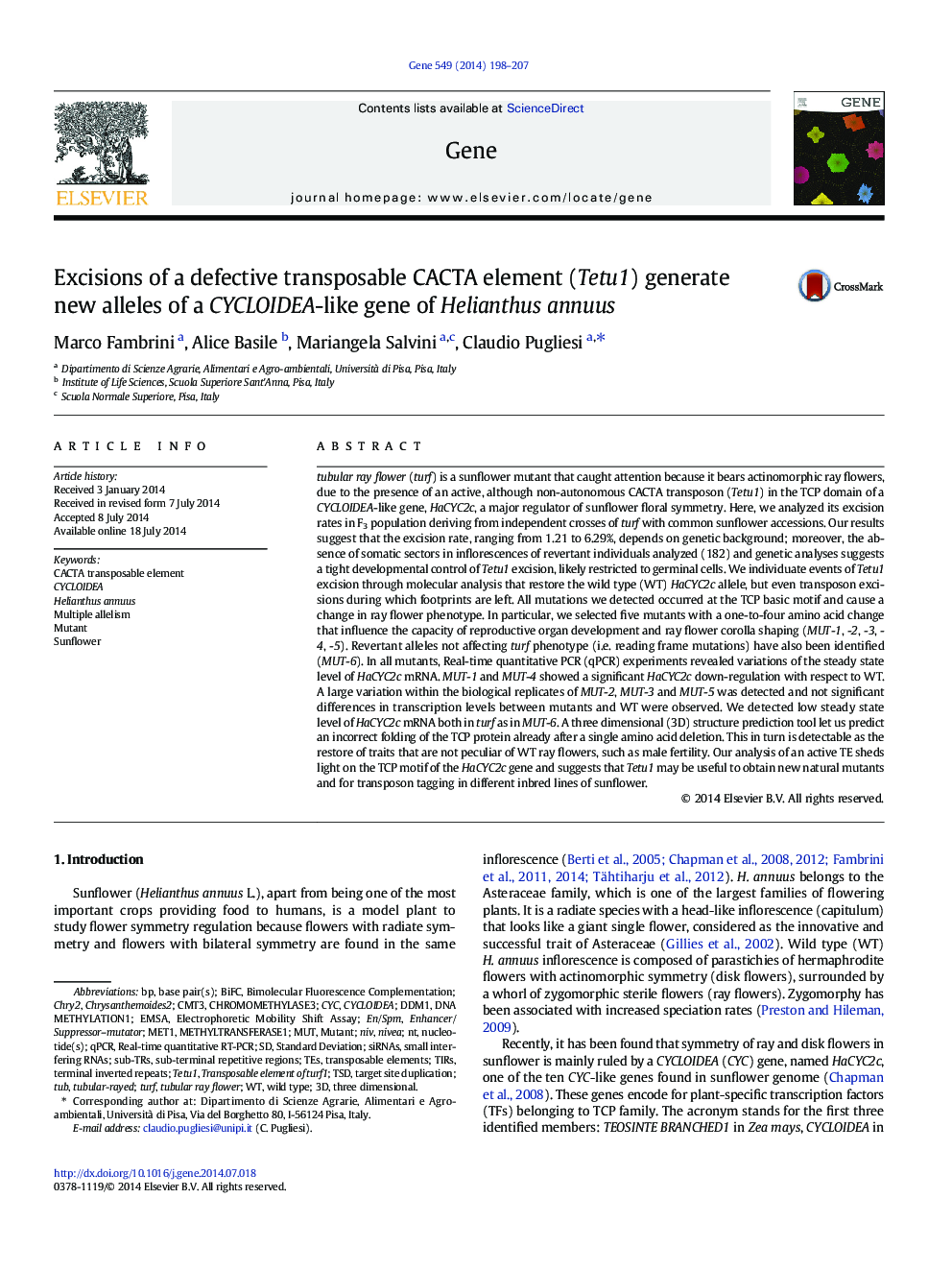| کد مقاله | کد نشریه | سال انتشار | مقاله انگلیسی | نسخه تمام متن |
|---|---|---|---|---|
| 2816274 | 1159923 | 2014 | 10 صفحه PDF | دانلود رایگان |

• Excision of a non-autonomous transposon occurred in germinal lineages of sunflower.
• The excision affected the TCP domain of HaCYC2c, generating different alleles.
• Mutated alleles showed dramatic alteration in the 3D structure of the TCP domain.
• HaCYC2c transcription was seriously down-regulated both in turf as in MUT-6.
• Mutants are characterized by a misshaping of ray flower corolla and sexual organs.
tubular ray flower (turf) is a sunflower mutant that caught attention because it bears actinomorphic ray flowers, due to the presence of an active, although non-autonomous CACTA transposon (Tetu1) in the TCP domain of a CYCLOIDEA-like gene, HaCYC2c, a major regulator of sunflower floral symmetry. Here, we analyzed its excision rates in F3 population deriving from independent crosses of turf with common sunflower accessions. Our results suggest that the excision rate, ranging from 1.21 to 6.29%, depends on genetic background; moreover, the absence of somatic sectors in inflorescences of revertant individuals analyzed (182) and genetic analyses suggests a tight developmental control of Tetu1 excision, likely restricted to germinal cells. We individuate events of Tetu1 excision through molecular analysis that restore the wild type (WT) HaCYC2c allele, but even transposon excisions during which footprints are left. All mutations we detected occurred at the TCP basic motif and cause a change in ray flower phenotype. In particular, we selected five mutants with a one-to-four amino acid change that influence the capacity of reproductive organ development and ray flower corolla shaping (MUT-1, -2, -3, -4, -5). Revertant alleles not affecting turf phenotype (i.e. reading frame mutations) have also been identified (MUT-6). In all mutants, Real-time quantitative PCR (qPCR) experiments revealed variations of the steady state level of HaCYC2c mRNA. MUT-1 and MUT-4 showed a significant HaCYC2c down-regulation with respect to WT. A large variation within the biological replicates of MUT-2, MUT-3 and MUT-5 was detected and not significant differences in transcription levels between mutants and WT were observed. We detected low steady state level of HaCYC2c mRNA both in turf as in MUT-6. A three dimensional (3D) structure prediction tool let us predict an incorrect folding of the TCP protein already after a single amino acid deletion. This in turn is detectable as the restore of traits that are not peculiar of WT ray flowers, such as male fertility. Our analysis of an active TE sheds light on the TCP motif of the HaCYC2c gene and suggests that Tetu1 may be useful to obtain new natural mutants and for transposon tagging in different inbred lines of sunflower.
Figure optionsDownload high-quality image (340 K)Download as PowerPoint slide
Journal: Gene - Volume 549, Issue 1, 1 October 2014, Pages 198–207